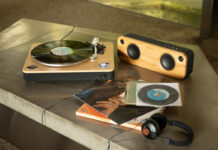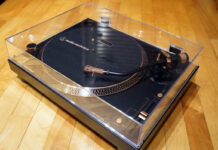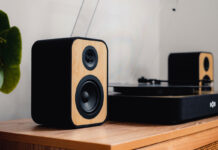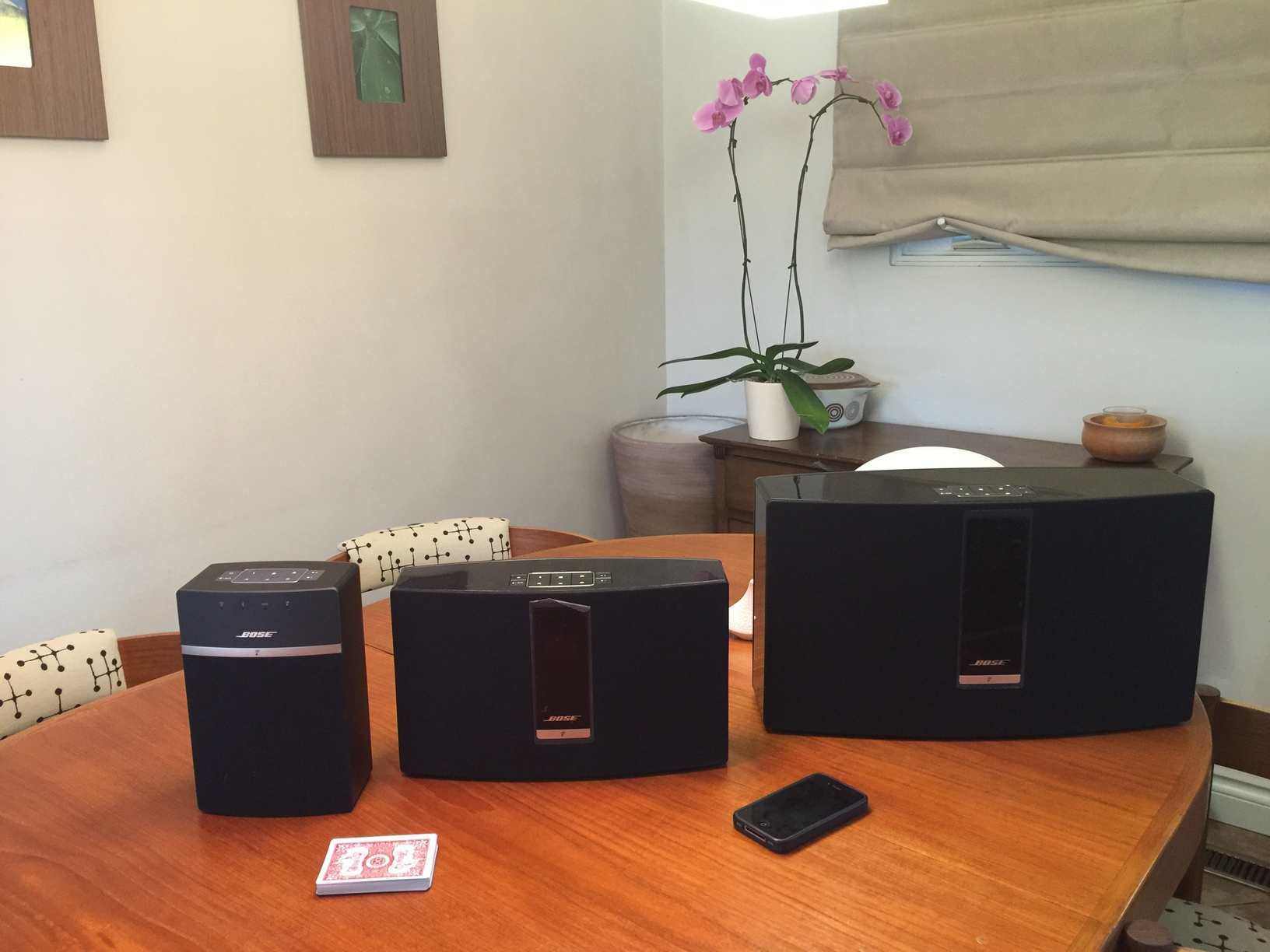 It’s nearly impossible to find someone using hardwired speakers to play music these days. Most people use Bluetooth wireless speakers; whether tiny and compact (but infinitely portable) or bigger, heavier, and louder.
It’s nearly impossible to find someone using hardwired speakers to play music these days. Most people use Bluetooth wireless speakers; whether tiny and compact (but infinitely portable) or bigger, heavier, and louder.
The speakers you choose will depend on where you plan to play your music, how loud you like it, how much you might move the speaker around, and how good you want the audio quality to be.
Bose offers a range of Wi-Fi speakers that allow you to adapt to changing rooms, or different situations, and different volume levels. Best Buy loaned me the SoundTouch trio to test and review for this article.
The Bose SoundTouch line is available at Best Buy
Reviewing the Bose SoundTouch trio
Bose SoundTouch Speakers
|
Bose SoundTouch is a line of three different speakers, all Wi-Fi enabled, that lets you expand and adjust to your home audio needs. The three speakers are the Soundtouch 10, the Soundtouch 20 and the Soundtouch 30.
Each of the speakers is portable, though they are substantially bigger and heavier as you go up in the line. The speakers will all stream from multiple music services, internet radio stations or your stored music library. You can play music on one speaker, or across multiple speakers, depending on your needs.
SoundTouch 10/20/30: The key differences
The major difference right off the bat is the size and weight of the individual speakers. While the SoundTouch 10 (photo immediately below) is the smallest and most compact, it also has the weakest sound. Now by weak in this context I mean comparatively, to the other speakers. It still sounds much clearer and stronger for example than my Jawbone mini Jambox, and I could only turn it up about two thirds of the way before the volume was unbearably loud. The SoundTouch 10 is also the only speaker in this line without a front display. This speaker is ideal for a smaller room, like a bathroom, or for a bedside table.
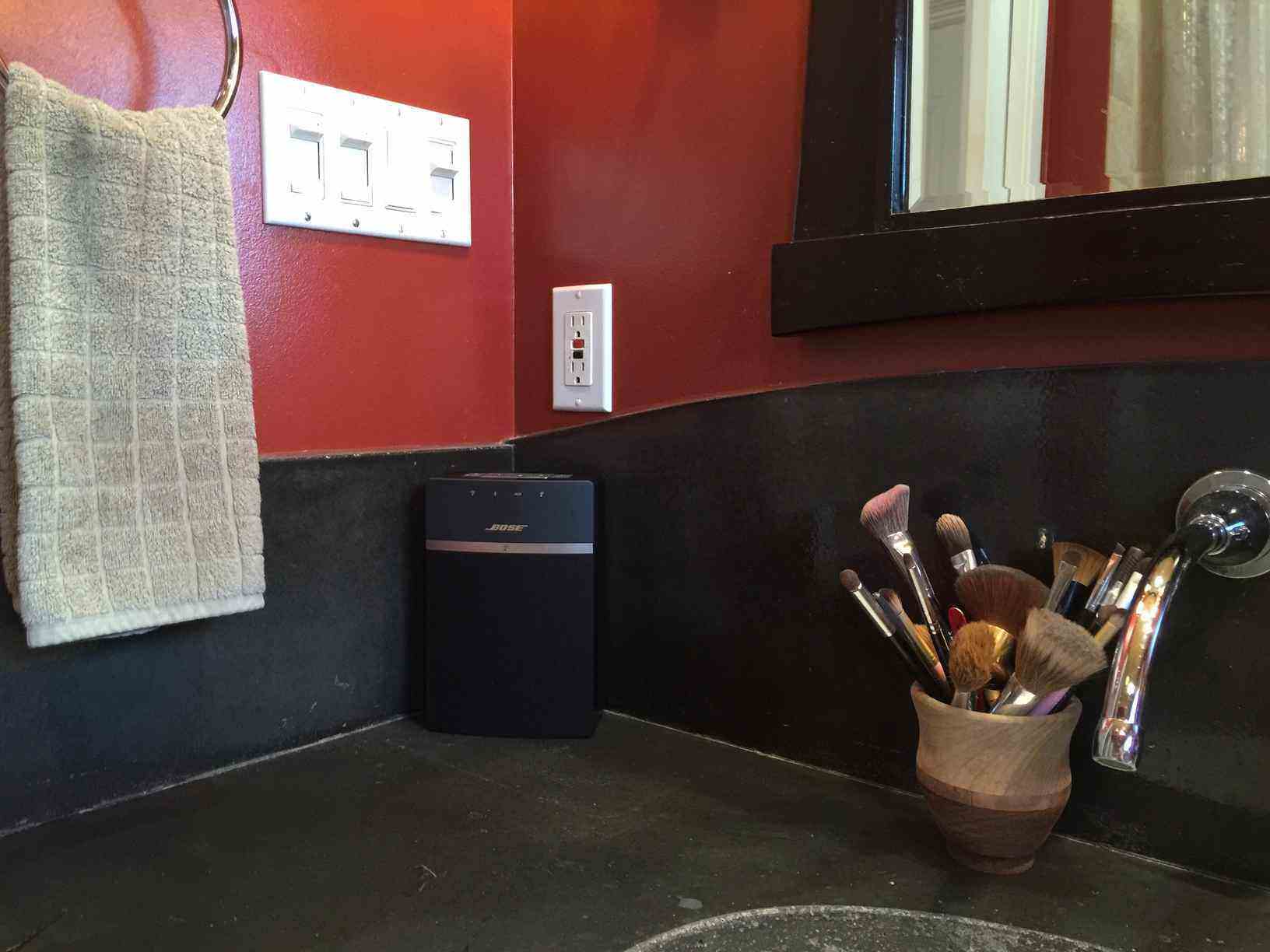 The SoundTouch 20 is a medium sized speaker, with a small digital display dividing the two speaker halves. The 20 is almost twice as big as the 10. It also weighs a good bit more. I stashed this speaker in my kitchen, but it would also work well in a living room or entry area.
The SoundTouch 20 is a medium sized speaker, with a small digital display dividing the two speaker halves. The 20 is almost twice as big as the 10. It also weighs a good bit more. I stashed this speaker in my kitchen, but it would also work well in a living room or entry area.
The SoundTouch 30 (photo below) by comparison to the other two units is big, heavy and awkward, both to move around the house, and to find a place to fit it and have it out of the way. The tradeoff with the large size is this speaker is by far the most powerful of the group. It’s about one-and-half times larger than the 20, and it too has a small digital display. You’ll want this one in a big room, as it has the power to fill the largest areas with lots of sound. For that reason, the SoundTouch 30 went into my living room. I placed it on the floor more for convenience, but that also provided nice thumping bass.
Bose SoundTouch Setup
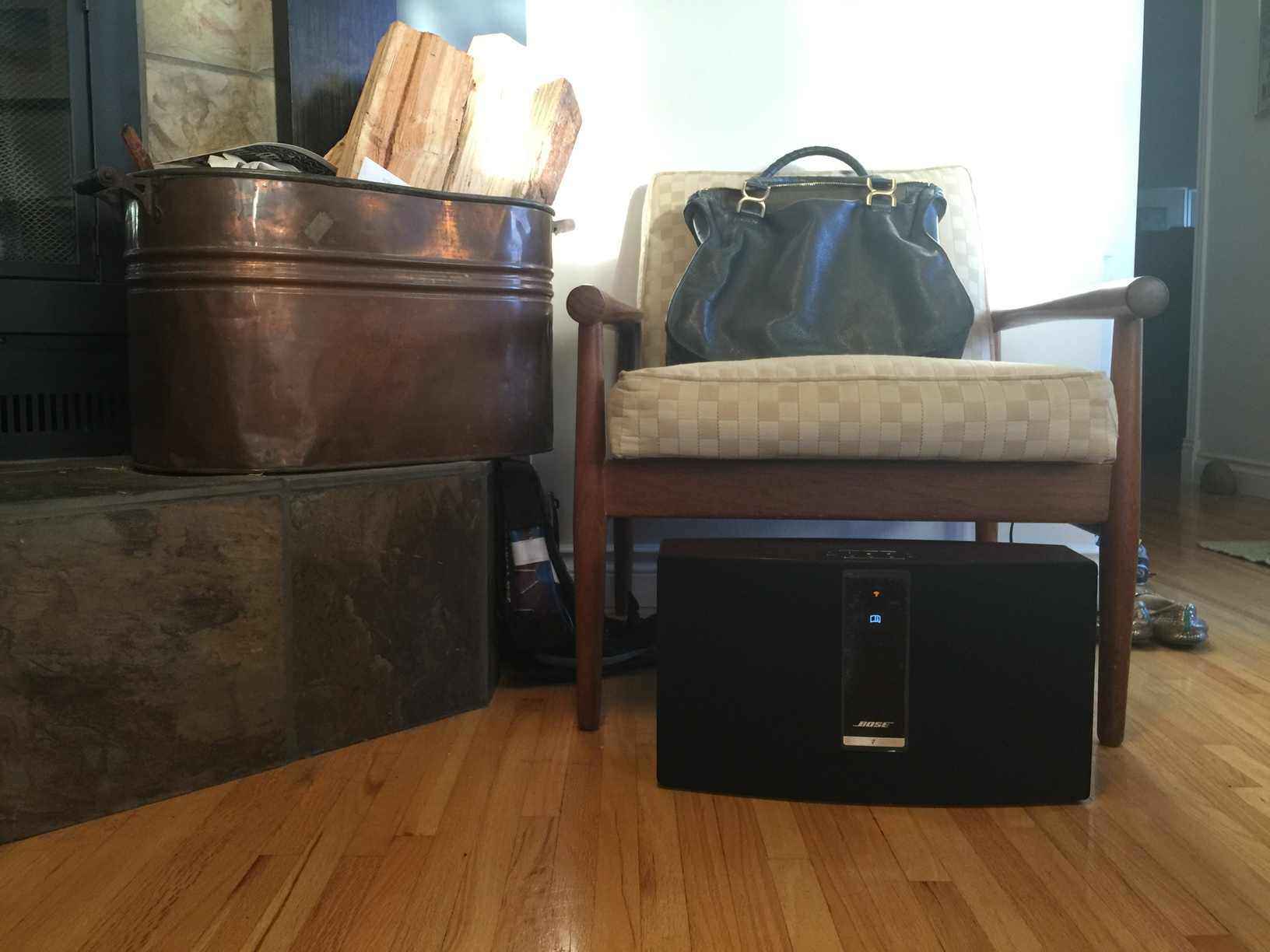 To set up these speakers you’ll need Wi-Fi and a smartphone or tablet. Setup was as simple as unboxing the speakers, plugging them into AC power, and then installing and loading the app. It was quick and easy. The only minor annoyance was that when I was adding new speakers (each speaker must be manually added to your system), I needed to re-log into the app even though I was already logged in.
To set up these speakers you’ll need Wi-Fi and a smartphone or tablet. Setup was as simple as unboxing the speakers, plugging them into AC power, and then installing and loading the app. It was quick and easy. The only minor annoyance was that when I was adding new speakers (each speaker must be manually added to your system), I needed to re-log into the app even though I was already logged in.
One other annoyance for me right out of the box is the shortness of the power cords. Each speaker has only about a 3-to-3.5 foot power cable, which made trying to get it plugged in and out of the way a challenge, because it’s not much longer than the shrimpy cords that come with some smart phones.
Hands On: Bose Soundtouch app
Bose’s free app gives you full remote control over individual speakers and the group as a whole.
The app, though rather basic, has most of the functions you’ll need or want. A numbered list of “presets” runs down the left side and you can program them with everything from internet radio channels to favourite streaming services.
Along the right side, there’s an “Explore” menu, with things like “internet radio,” “Bluetooth,” and “add music,” which lets you add-on music services like Deezer or Spotify, as well as “Settings”.
Along the bottom is a tray that both slides left to right, and allows you to pull it up into a full menu. Choosing a speaker from the sliding tray allows you to pick one speaker for playback. Using the pull-up menu gets you more in-depth, and will allow you to add or subtract speakers to a group if you’re trying to play music in several rooms at once.
Connecting and Reconnecting
I found the need to constantly connect and reconnect on the Soundtouch system a pain. When I’d swap from internet radio to Bluetooth (to play music via my phone’s music library), I needed to reconnect the phone every time. I also required reconnecting to Bluetooth when I’d have the system off for a day, then try to power it back up. Reconnecting involves going to the Bluetooth menu in my phone’s settings, and reestablishing the Bluetooth signal, then returning to the app to play what I want. It felt like a needless extra step and was a bit frustrating, however it’s not uncommon among Bluetooth devices.
Bizarrely, after nearly two weeks of testing, and dealing with the connectivity delays and needing to connect and reconnect Bluetooth, on the last day of testing, the entire system seemed to work seamlessly. I didn’t need to reestablish Bluetooth when powering up, there was no 3-4 second delay between songs, though there was still about a 10 second delay switching between services, and I did still need to reconnect to the phone’s Bluetooth when switching from internet radio back to my music menu. I don’t understand why these issues are intermittently problematic, but they are.
Bose SoundTouch: How the speakers sound
I can make absolutely no complaints about how the speakers sounded. Whether it was music (I tried rock, hip hop, and country) or podcasts, as well as listening to internet radio, everything sounded great. Voices were true and not tinny. Music sounded full and rich, and particularly with the SoundTouch 20 and 30 the bass was fantastic. Sounds that were really good on the small SoundTouch 10 speaker (like hip hop or rap) sound even better on the larger 20 and really great on the 30, with a more powerful bass. I did notice that voices on the 10 started sounding overmodulated and scratchy at about two-thirds volume, but since that’s probably way louder than you’ll ever need to hear a podcast, it’s probably not a problem.
The first time I tried playing music, it played easily across all three speakers, and I was able to switch between them without problem. When switching between different speakers, however there is about a four second delay, and the music cuts out as the system makes adjustments. I was trying to add speakers via the multi-room feature at our Thanksgiving dinner but it ended up being rather annoying to the guests because the music would cut out across all speakers for a few seconds any time I made adjustments to which speakers were playing back. It’s worth noting there’s also about a 3-4 second delay from the time I picked a new song or audio source, until it actually began playing.
Multiple Speaker Function
To use multiple speakers, you must first designate one of them as the primary. From there, you can add or subtract other speakers as you need to. It’s good to note you can also control volume on individual speakers, or across the group, which is an excellent versatility feature; you can keep the living room loud, for example, while the dining room where you’re eating has a softer volume.
During my initial use of the app everything worked seamlessly together. It was when I started turning the system and the individual speakers on and off and trying to reconnect to them and among them, that problems started.
In one case, I’d been playing music across all speakers, and then when I logged in the next morning the Bose still had my living room speaker assigned as the primary speaker, even though I was trying to put the radio on in the bathroom. I was unable to connect to it because it was not the ‘primary’ speaker. I felt like a dummy, but I could not figure out how to change which one is primary nor could I delete any of the speakers from the system. So, no radio in the bathroom for the first few days while I figured out why I couldn’t seem to play music on just one speaker any more.
Responsive Help and Customer Service
Later when I had more time, I hit up Twitter where I asked for help from Bose. Fortunately Bose is super responsive on social media, and questions I asked were answered quickly, and simply, and I had issues fixed right away. (More on the primary speaker issue below)
Connectivity/Wi-Fi
After a couple days of testing individual speakers, I tried to put music on all of the speakers using “Play Everywhere” mode. Except this time I had great difficulty getting it to play across all three. The sound would intermittently cut out to some speakers, then when I would try to change speakers, a different one would cut out.
This was particularly frustrating because the display of each speaker would show that it was indeed connected and playing music, but nothing would come out of the speakers. I even tried cranking up the volume buttons both on the speaker itself and on the app, but nothing. The app would also show the play anywhere feature was activated, when in fact music would only be playing on one of the three speakers.
After about 15 minutes of trying to troubleshooting what was essentially audio “whack-a-mole,” I gave up and used my Jambox.
I Tweeted Bose to ask what the connectivity problems might have been related to and got excellent customer service again and a reasonable explanation:
“Play everywhere” mode requires significantly more Wi-Fi bandwidth than playing the speakers individually, mostly in order to keep them synchronized together. If one or more of your speakers has weak signal to your Wi-Fi, this might cause intermittent audio, even when it works fine for solo playback. The easiest way to check on this is to determine the RSSI rating of each of your speakers.”
I did perform this test with each of the three speakers and got “fair” results. I then marched one of the speakers around the house, checking connectivity all the way. I got the best signal strength (“Good”) when the speaker was about 10 feet from by router (all other Wi-Fi devices in my home were showing a full signal at that time). So it’s worth keeping in mind that if you have weak Wi-Fi, thick walls, or general connectivity issues these speakers (if you want more than one) could pose a problem for you.
Ease of Use (or: How to adjust Primary Speaker)
As I mentioned above, I also experienced a bit of frustration trying to play the radio on just one speaker in the mornings. I spent a good 10 minutes after waking up trying to get the radio on, on just the speaker in my bathroom, to absolutely no avail. There seemed to be no way to change the primary speaker.
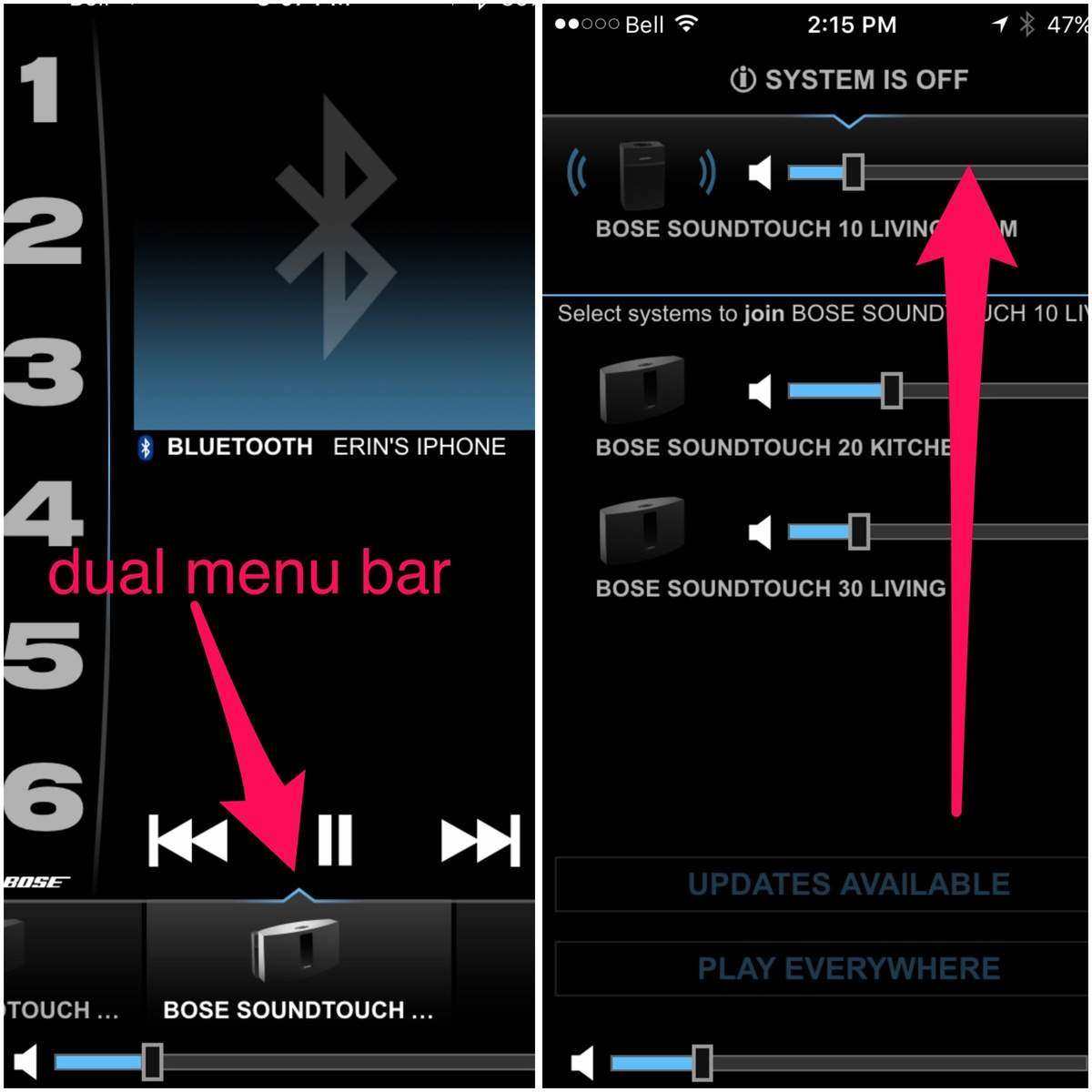 I think that’s because it’s not immediately self-evident that the bottom menu within the app is both a sliding menu and a pull-up menu, and that when working as a slider, it will only control one speaker at a time. As it was explained to me by the great folks at Bose customer service, when used as a pull up menu it allows you to make adjustments to the group (under the primary speaker you just designated). If you want to change the primary speaker, you need to select your preferred speaker from the sliding menu, then pull the menu up to adjust your group. This will be clear as mud to anyone without a system, but here’s hoping it’s helpful to anyone dealing with the same frustration as I was.
I think that’s because it’s not immediately self-evident that the bottom menu within the app is both a sliding menu and a pull-up menu, and that when working as a slider, it will only control one speaker at a time. As it was explained to me by the great folks at Bose customer service, when used as a pull up menu it allows you to make adjustments to the group (under the primary speaker you just designated). If you want to change the primary speaker, you need to select your preferred speaker from the sliding menu, then pull the menu up to adjust your group. This will be clear as mud to anyone without a system, but here’s hoping it’s helpful to anyone dealing with the same frustration as I was.
Overall, I found the Bose app functional, but clunky and confusing; particularly that dual purpose bottom menu. I feel like a simple drag and drop or even a “click to designate primary speaker” option would be easier to navigate and understand.
Audio Sync Issues
Another problem I experienced on a couple of occasions, was the audio being out of sync by a bit more than a second from speaker to speaker. This appeared to crop up after I’d pause some content for a couple minutes then replay it. In one case it was out of sync right from start up. My solution was to stop playback across all devices, shut the speakers down, reboot the app, and start again. Not ideal, since in those cases I needed to reconnect to Bluetooth all over again. That would result in a several minute delay while I got things working again.
The Verdict
There’s no arguing how great these speakers sound. Each of the three would be a great addition to any home, and the versatility of being able to pick from the different sizes for different rooms is a great feature of the line. Whether you want the SoundTouch 10 for a small bathroom, or the SoundTouch 30 for a living room or large party space, you’ll be impressed with the quality and volume capabilities of sound output.
I was disappointed in the app and the user interface, as well as the connectivity issues. Particularly at Bose’s price point, the interface should be flawless and easy to use without needing assistance from customer service (as nice and helpful as they were) and I don’t think you shouldn’t have to fight with or fuss over your music.
That said, I’d certainly get one of these speakers, probably the mid-sized, mid-priced, medium-powerful SoundTouch 20 for my home, but until Bose is able to update the firmware I’d wait on expanding my lineup. However it’s good to see that if you encounter any of the issues I’ve noted, Bose does have great and responsive customer service to help you out. You can also leave a comment here or on one of the Best Buy community forums to get answers from others who use Bose.
The Bose SoundTouch line is available at Best Buy

